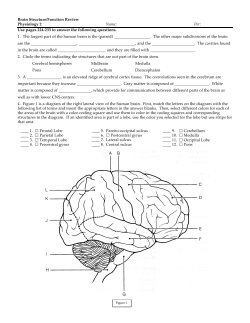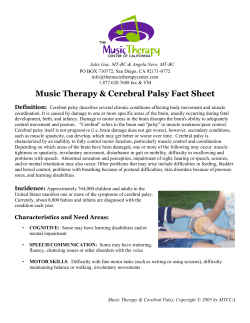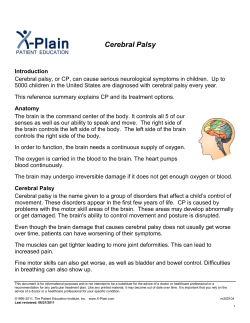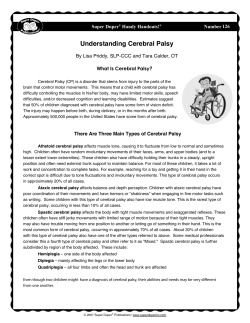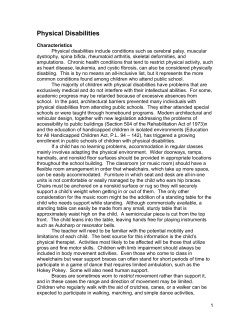
Document 10271
LONDON, SATURDAY 1 JANUARY 1977 BRITISH JOURNAL Treatment of acute cerebral infarction A nihilistic approach to the treatment of acute cerebral infarction is understandable. Striking advances in our knowledge of its pathophysiology have not been matched by advances in treatment. There are three major problems: the accuracy of the diagnosis; the possibility of achieving immediate benefit to the patient; and the long-term effect of treatment in the acute phase. Traditional teaching that the clinical evolution of a stroke provides evidence ofcerebral infarction must now be discarded, at least in lesions sited in the cerebral hemisphere. A major source of diagnostic error is a localised intracerebral haematoma without any appreciable extravasation of blood into the cerebrospinal fluid. Hypertension is certainly associated with a high incidence of cerebral infarction,l but the level of the blood pressure is of no value in differentiating between cerebral haemorrhage and infarction in the acute phase.2 Clinical .observation suggests that when the diastolic blood pressure is 115 mm Hg or above then an intracerebral haematoma will be responsible for the stroke in 150% of all patients and in a much higher proportion of patients with recurrent episodes.3 There have been four main lines of attack in attempted treatment. Firstly, vasodilators may be given to try to increase the total cerebral blood flow. Secondly, attempts may be made to control cerebral oedema-a major factor in the morbidity and mortality after infarction. The third and fourth approaches are the use of inhaled CO2 and low-molecular-weight dextran to attempt to control further formation of thrombus and the aggregation of platelets and erythrocytes in the microcirculation close to the area of ischaemia. The doctor should probably decide not to use any one of these methods if the patient has early impairment of consciousness, loss of conjugate gaze to the affected side, and a dense hemiplegia-all of which indicate a high immediate mortality or a very poor recovery offunction.4 Carbon dioxide may be an effective cerebral vasodilator, but not in every patient with occlusive vascular disease.' Nevertheless, careful studies" 7 leave little doubt that CO2 has no useful role in treatment. There is also experimental evidence that induced hypocarbia (reducing the PaCO2 to 25 mm) may protect ischaemic brain tissue,8 but clinically a controlled trial showed no evidence in its favour.9 Papaverine will certainly increase cerebral blood flow,'0 and one control study indicated a significant clinical effect in the treated group," though this finding could not be confirmed by another study.'2 One objection to vasodilators, not as yet confirmed by clinical studies, is the possibility of inducing intracerebral steal.'3 Since it constricts the cerebral vessels, aminophylline does not ©) BRITISH MEDICAL JOURNAL 1977. All reproduction rights reserved. share the usual objection to vasodilators, and some observations suggest that it may be of some value in the restricted stroke.'4 Ever since the original observation that the effects of cerebral oedema on intracranial pressure could be reduced many attempts have been made to control the oedema that succeeds cerebral infarction. Success for the use of glycerol has been claimed in two clinical trials,'5 16 but the use of steroids has yielded totally conflicting evidence. Evidence in favour of their use came from two studies on a total of 43 patients.'7 18 Other work, however,19 showed no evidence that steroids could control experimental ischaemia, and a double blind study in 50 patients using dexamethasone20 found it to have no clinical value. We now know that anticoagulants have no value in treating completed stroke. Nevertheless, there is still some evidence2' that the use of anticoagulants in the early hours of a developing cerebral infarction may be of some value-if the diagnosis can be made with confidence. If there is any evidence of systemic hypertension then anticoagulants should be ruled out because of the possibility of cerebral haemorrhage developing as a complication of treatment. Finally, dextran has been used in ischaemic cerebral infarction. One controlled trial22 had the great merit that not only were the observations made in the acute stage but the survivors were also studied six months later. The study indicated that there could be an appreciable improvement in patients with severe stroke in terms of survival; but these survivors were nevertheless severely disabled, and, just as important, six months later no significant benefit could be detected. In less severely affected patients in the acute phase no useful effect of treatment was observed. Nor has the combination of dexamethasone and dextran proved effective; in a recent controlled trial in Helsinki no differences were found between treated and control groups.23 Thus the acute treatment of cerebral infarction still presents a depressing picture, but one ray of hope remains. The introduction of computer assisted axial tomography, bringing as it does such an increase in diagnostic accuracy, may also provide a method of serially monitoring the effects of drug treatment of cerebral oedema in a manner hitherto impossible. Nevertheless, as often happens with new techniques, this method may pose more questions than it answers. Baker, A B, Resch, J A, and Loewenson, R B, Circulation, 1969, 39, 701. Aring, C D, and Merritt, H H, Archives of Internal Medicine, 1935, 56, 435. 3Hutchinson, E C, and Acheson, E J, Strokes. London, Saunders, 1975. 2 NO 6052 PAGE 1 2 Oxbury, J M, Greenhall, R C D, and Grainger, K M R, British Medical J'ournal, 1975, 3, 125. Fazekas, J F, and Alman, R W, Archives of Neurology, 1964, 11, 303. 6 Millikan, C H, Archives of Neurology and Psychiatry, 1955, 73, 324. 7McHenry, L C, et al, Archives of Neurology, 1972, 27, 403. 8 Soloway, M, et al, Anesthesiology, 1968, 29, 975. 9 Christensen, M S, in Brain and Blood Flow, Proceedings of the Fourth International Symposium on the Regulation of Cerebral Blood Flow, ed R W Ross Russell. London, Pitman, 1970. 10 Jayne, H W, et al, J3ournal of Clinical Investigation, 1952, 31, 111. 1 Meyer, J S, et al, Journal of the American Medical Association, 1965, 194, 957. 12 McHenry, L C, et al, New England3Journal of Medicine, 1970, 282, 1167. 13 Olesen, J, and Paulson, 0 B, Stroke, 1971, 2, 148. 1 Geismar, P, Marquardsen, J, and Sylvest, J, Acta Neurologica Scandinavica, 1976, 54, 173. 15 Meyer, J S, et al, Lancet, 1971, 2, 993. *6 Meyer, J S, et al, Stroke, 1972, 3, 168. 17 Russek, H I, Zohman, B H, and Russek, A S, J'ournal of the American Geriatrics Society, 1954, 2, 216. 18 Patten, B M, et al, Neurology, 1972, 22, 377. 19 Plum, F, and Posner, J B, Archives of Neurology, 1963, 9, 571. 20 Bauer, R B, and Tellez, H, Stroke, 1973, 4, 547. 21 Millikan, C H, Stroke, 1971, 2, 201. 22 Matthews, W B, et al, Brain, 1976, 99, 193. 23 Kaste, M, Fogelholm, R, and Waltimo, 0, British Medical3Journal, 1976, 2, 1409. Surgeons and the 20-80 rule Our American colleagues have an enthusiasm for organisational analysis, a zest for self-criticism, and an ability to get-up-and-go that produces reports which often put us to shame. Recent studies on surgical manpower and work loads are no exception and serve to remind us that, though Jeremy Bentham is credited with originating the planning maxim "Investigation, legislation, examination, and report," the initiative has now passed across the Atlantic. The Study of Surgical Services in the United States (SOSSUS) has become relatively well known (at least to surgeons) both here and in America.' An overlapping investigation from Harvard2 3 has now added support to the conclusion that for the United States as a whole there are too many surgeons chasing too little operative work and that some rationalisation (dread word for us in Britain) could achieve substantial economies. No doubt the methods used will be criticised, but on the whole the conclusions seem inescapable and do not conflict with the fact that many surgeons are extremely busy. The distribution of activity seems to follow an old engineering design law (the 20-80 rule) which states that 20% of the people do 80% of the work (the same rule is also said to apply to such matters as the consumption of alcohol and social services). The design oftheir investigations did not permit the authors of SOSSUS nor those of the more recent Harvard study to comment on the possibility that inside the skew distribution of surgical labour there is also much "unnecessary surgery," about which Dunea was recently writing in these columns.4 Nevertheless, as he pointed out, the recent surgical statistics in the USA do allow the inference that nonspecialists doing surgery are probably more likely to misjudge the medical indications for it. Bunker5 hinted at a similar conclusion some years ago. These assessments of the work of surgeons are not without serious implications in any cost-conscious society. There seems little doubt that two chain reactions will follow. Firstly-and this will be found only in societies in which fee-forservice is the way of life-there will be a gradual change in the earning structure of the man who at the moment does surgery BRITISH MEDICAL JOURNAL 1 JANUARY 1977 but lacks the appropriate specialist qualifications; for better' or for worse, he will be gradually squeezed out by boardqualified surgeons. The process may be slow so long as a good income can be earned from a fairly light work load, so reducing the impetus of the specialist to build up his practice. Secondly, and of greater potential relevance to us in Britain, is that there is already a strong movement to reduce the number of surgeons in training and thus the number of residency training programmes in the United States (equivalent to our higher surgical training schemes). Such a reduction in turn will inevitably affect quality of staffing, and if the trend were followed in Britain might arrest or reverse the trend (on the whole desirable) towards spreading senior registrars into socalled non-teaching hospitals. In Britain, where we think we have got the numbers in higher surgical training right in relation to the jobs available, the problem of work loads is inextricably linked with those of resources and staffing. Unfortunately we lack facts, though an outrider of SOSSUS visiting Britain in 1975 found wide variation of commitment to clinical surgery in a small cross section of British surgical clinicians.6 In the absence of data it seems unrealistic to make sweeping changes in resource allocation among regions7; nor should we be over-hasty redeploying either fully trained surgeons or those accepted into higher surgical training. Though we might not wish to reproduce the complexities of SOSSUS or to introduce a European equivalent of the California Relative Value-Weighted Operative Work Scale (four tonsillectomies equal one hernia), we cannot afford to go on making virtually wholly non-numerical statements, particularly when administrators will then, faute de mieux, use crude economic yardsticks. Perhaps the Royal Colleges of Surgeons in Britain, as guardians of the quality of the surgery here, might take the lead in telling us what surgeons really do; what relationship this has to need; and where, in detail, there is dissonance between the two. Moore, F D, Surgical Manpower: Statistical overview and distributional study. Surgery in the United States: a summary report of the Study on Surgical Services for the United States. Baltimore, American College of Surgeons, 1975. 2 Nickerson, R J, et al, New England3Journal of Medicine, 1976, 295, 921. 3 Nickerson, R J, et al, New England Jrournal of Medicine, 1976, 295, 982. 4 Dunea, G, British Medical_Journal, 1976, 2, 1180. 5 Bunker, J P, New England Journal of Medicine, 1970, 282, 135. 6 Doorey, A, 1975. Unpublished data on file with Dr F D Moore, Boston. 7 British Medical Journal, 1976, 2, 1280. Safety of children in cars The importance which is rightly attached to child pedestrian casualties has tended to overshadow the risks to children of travelling as passengers in cars. During 1974 in Britain no fewer than 2260 children under 15 years old were killed or seriously injured in cars. Cars are designed for adults and not for children, so that the protection of children travelling in them presents special problems, which have been studied by the Transport and Road Research Laboratory. The results need to be more generally known.1 Special allowance has to be made for changes which occur in the child's physical development until he can wear an adult type seat belt. Very young infants should be carried in a carry-cot placed transversely across the car. Restraints can be obtained which attach to the bodywork of the car and so prevent the infant being ejected. As soon as the child can sit up, a, moulded bucket seat with a built-in harness can be used.
© Copyright 2025

